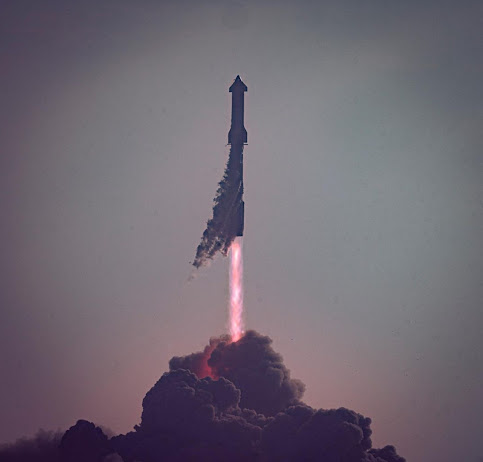Like most people with an interest in spaceflight, I watched SpaceX’s launch of a Starship vehicle on April 20. Following up on that liftoff, yesterday I had an opportunity for an in-depth viewing of the events from that day, courtesy of the Everyday Astronaut website, which has crafted an excellent collection of launch angles gathered into a single video. It’s a 14-minute portrait of the doomed flight of – I’m sure you can say it with me by now – “the most powerful rocket ever launched!”
My reactions during this granular viewing of the new video were
not much different than my feelings witnessing the initial launch video stream.
From the prolonged pad blasting hurling debris and an oddly drifting liftoff to
the destruction of the vehicle after control was ultimately lost, any sense of
wonder was suppressed somewhat by a series of “That doesn’t look right…” and “Is
that supposed to do that?” moments.
In the days since the Starship’s short-lived and explosive
flight, there has been a lot of scorching debate over the development
methodologies of both NASA and SpaceX. I’m optimistic that there are people
cheering on all spaceflight developments - no matter the source - as a silent
majority. But there has been no shortage of hot-headed vitriol publicly
expressed in the wake of the Starship’s ascension, perhaps inevitably
reflecting the kind of divisiveness now characterizing American society.
Many people on one side criticize NASA for swallowing
massive outlays of government funding in service of what they perceive to be a
plodding pace of progress. The agency’s supporters point to last year’s first unmanned
mission of the Space Launch System, one that successfully sent the massive
vehicle and its Artemis payload into orbit, followed by a lengthy excursion to
the moon where numerous orbital exercises were achieved before a successful
return to Earth. Striking back, critics bizarrely lambast SLS for its
dependence on older, proven engine technology, as if pulling off what was essentially
an incredibly complex proof-of-concept lunar mission should not really count.
SpaceX, on the other hand, is often judged by rapid progress
that many believe is measured in the outcome of “try it and see what happens”
moments. The attitude is personified by Elon Musk’s April 14 tweet: “Success
maybe, excitement guaranteed.” It’s an approach that has drawn the passionate support
of a huge SpaceX fan base, with a disturbing undercurrent bearing cheers for the
megalomaniac musings of the erratic, polarizing Musk.
Food for debate: if Starship was a NASA program, would a
flight at this development stage ever have been attempted?
Regardless, SpaceX and NASA are locked in as partners in the
exploration of our solar system and the ramping up of ambitions for manned
spaceflight, dependent on each other. One can only hope that the serious
working relationships necessary among both entity’s branches of administration,
science, and engineering are shielded from the hot keyboard conflicts being
waged by the public on social media battlefields.










